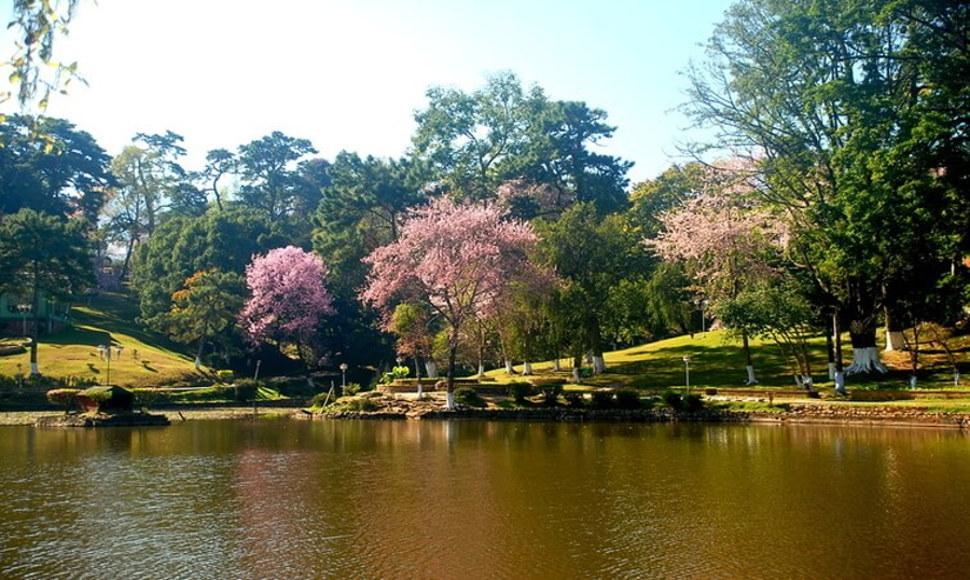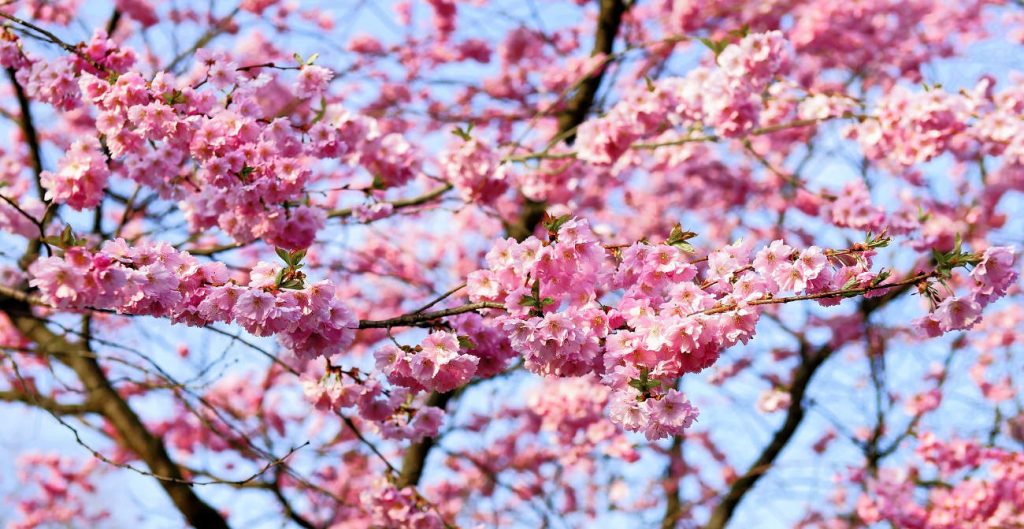SHIMLA, India (ViaNews) - Of many exotic attractions Japan offers, the poetic image of pink cherry blossom flower of Springtime stands out. Among many other things, Cherry Blossom appreciation now has another world-class offer. Japan and Korea, has gotten a near western cousin joining them in this spectacle, Khasi Hills of Meghalaya, India.
Prunus cerasoides, or the Wild Himalayan cherry tree, reaches full-fledged beauty by autumn, as opposed to the spring flowering in Japan and Korea. Actually, it has long been a wild tree in Shillong and adjacent areas and only recently been rediscovered, as city’s charm by the locals. Last year, on November, Shillong hosted India’s first Cherry Blossom Festival and now it is back on time. The fest is hosted over 8-11 November 2017, in multiple locations around Shillong. It will be organized by the state government, like last year, it will be kept open and free for all tourists.
[caption id="attachment_2684" align="aligncenter" width="970"]

Cherry blossom. Photo by: Forests and Environment Department of Meghalaya.[/caption]
The India International Cherry Blossom Festival is organized by the state government with the Institute of Bio-resources and Sustainable Development and the Indian Council for Cultural Relations. It has been reported that the State government and the Institute had planted over 3000 saplings over the city in 2015 to study the indigenous trees. An extension of the appreciation is rumored in nearby states. A future parallel project is underway in the state of Himachal Pradesh as well.
The very first sapling for a tourism event in grand scale was planted by the Honourable Chief Minister of Meghalaya, Dr. Mukul M. Sangma on May 14, 2015. Thousands of saplings were planted around Wards Lake, roadsides and around the capital. Approximately 2,000 cherry plants were planted by Forest and Environment Department during the months of July-August 2015. And locals have been showing an active appreciation and involvement. North Eastern states, Seven Sisters, have been the pioneer of eco-tourism in India for quite some time.
As per statistics compiled by the market research division of the Union tourism ministry, during 2015 the number of domestic tourists' visits to the states was 1,432 million compared to 1,282.8 million in 2014, registering a growth of 11.63 percent. But none of the Seven Sisters reached the top 10 percentage, mainly because of the accessibility and transportation problems.
Also, the diversity of the country and its extreme area makes the comparative study problematic in understanding the situation. And efforts like this would be a great boost to the tourism industry. Nevertheless, increase in a number of foreign tourists, has been the most to North East than the rest of the parts in the country.
The Cherry Blossoms plant is believed to have a positive psychological impact and is a heaven for photography enthusiasts. Future prospectus as shooting locations for the film industry and increasing movies industry is another prediction worth paying attention to.
[caption id="attachment_2683" align="aligncenter" width="640"]

Cherry blossom.[/caption]
Director of IBSD Prof. Dinabandhu Sahoo initiated the launch of the festival because of his fascination for Cherry Blossom {Sakura} of Japan. Two years of red tape and convictions with the government was behind the curtain rising of last year’s mega event. And this time, it is promised to be bigger and better.
In Japan, the flowers are deeply symbolic: their short-lived existence taps into a long-held appreciation of the beauty of life and it is associated with nation’s cultural heritage. The blossoms also, quite literally, symbolize new beginnings, with April 1 being the first day of both the financial and academic year in Japan.
Since this is a tradition in inception in India, there isn’t much legacy to associate the same with. But the surreal beauty of colored sky and roadways doesn’t seem to need any preface to have it embedded in local culture. The continuation of last year’s tradition says that, and we can only be positive and hope for more.
 Cherry blossom. Photo by: Forests and Environment Department of Meghalaya.[/caption]
The India International Cherry Blossom Festival is organized by the state government with the Institute of Bio-resources and Sustainable Development and the Indian Council for Cultural Relations. It has been reported that the State government and the Institute had planted over 3000 saplings over the city in 2015 to study the indigenous trees. An extension of the appreciation is rumored in nearby states. A future parallel project is underway in the state of Himachal Pradesh as well.
The very first sapling for a tourism event in grand scale was planted by the Honourable Chief Minister of Meghalaya, Dr. Mukul M. Sangma on May 14, 2015. Thousands of saplings were planted around Wards Lake, roadsides and around the capital. Approximately 2,000 cherry plants were planted by Forest and Environment Department during the months of July-August 2015. And locals have been showing an active appreciation and involvement. North Eastern states, Seven Sisters, have been the pioneer of eco-tourism in India for quite some time.
As per statistics compiled by the market research division of the Union tourism ministry, during 2015 the number of domestic tourists' visits to the states was 1,432 million compared to 1,282.8 million in 2014, registering a growth of 11.63 percent. But none of the Seven Sisters reached the top 10 percentage, mainly because of the accessibility and transportation problems.
Also, the diversity of the country and its extreme area makes the comparative study problematic in understanding the situation. And efforts like this would be a great boost to the tourism industry. Nevertheless, increase in a number of foreign tourists, has been the most to North East than the rest of the parts in the country.
The Cherry Blossoms plant is believed to have a positive psychological impact and is a heaven for photography enthusiasts. Future prospectus as shooting locations for the film industry and increasing movies industry is another prediction worth paying attention to.
[caption id="attachment_2683" align="aligncenter" width="640"]
Cherry blossom. Photo by: Forests and Environment Department of Meghalaya.[/caption]
The India International Cherry Blossom Festival is organized by the state government with the Institute of Bio-resources and Sustainable Development and the Indian Council for Cultural Relations. It has been reported that the State government and the Institute had planted over 3000 saplings over the city in 2015 to study the indigenous trees. An extension of the appreciation is rumored in nearby states. A future parallel project is underway in the state of Himachal Pradesh as well.
The very first sapling for a tourism event in grand scale was planted by the Honourable Chief Minister of Meghalaya, Dr. Mukul M. Sangma on May 14, 2015. Thousands of saplings were planted around Wards Lake, roadsides and around the capital. Approximately 2,000 cherry plants were planted by Forest and Environment Department during the months of July-August 2015. And locals have been showing an active appreciation and involvement. North Eastern states, Seven Sisters, have been the pioneer of eco-tourism in India for quite some time.
As per statistics compiled by the market research division of the Union tourism ministry, during 2015 the number of domestic tourists' visits to the states was 1,432 million compared to 1,282.8 million in 2014, registering a growth of 11.63 percent. But none of the Seven Sisters reached the top 10 percentage, mainly because of the accessibility and transportation problems.
Also, the diversity of the country and its extreme area makes the comparative study problematic in understanding the situation. And efforts like this would be a great boost to the tourism industry. Nevertheless, increase in a number of foreign tourists, has been the most to North East than the rest of the parts in the country.
The Cherry Blossoms plant is believed to have a positive psychological impact and is a heaven for photography enthusiasts. Future prospectus as shooting locations for the film industry and increasing movies industry is another prediction worth paying attention to.
[caption id="attachment_2683" align="aligncenter" width="640"] Cherry blossom.[/caption]
Director of IBSD Prof. Dinabandhu Sahoo initiated the launch of the festival because of his fascination for Cherry Blossom {Sakura} of Japan. Two years of red tape and convictions with the government was behind the curtain rising of last year’s mega event. And this time, it is promised to be bigger and better.
In Japan, the flowers are deeply symbolic: their short-lived existence taps into a long-held appreciation of the beauty of life and it is associated with nation’s cultural heritage. The blossoms also, quite literally, symbolize new beginnings, with April 1 being the first day of both the financial and academic year in Japan.
Since this is a tradition in inception in India, there isn’t much legacy to associate the same with. But the surreal beauty of colored sky and roadways doesn’t seem to need any preface to have it embedded in local culture. The continuation of last year’s tradition says that, and we can only be positive and hope for more.
Cherry blossom.[/caption]
Director of IBSD Prof. Dinabandhu Sahoo initiated the launch of the festival because of his fascination for Cherry Blossom {Sakura} of Japan. Two years of red tape and convictions with the government was behind the curtain rising of last year’s mega event. And this time, it is promised to be bigger and better.
In Japan, the flowers are deeply symbolic: their short-lived existence taps into a long-held appreciation of the beauty of life and it is associated with nation’s cultural heritage. The blossoms also, quite literally, symbolize new beginnings, with April 1 being the first day of both the financial and academic year in Japan.
Since this is a tradition in inception in India, there isn’t much legacy to associate the same with. But the surreal beauty of colored sky and roadways doesn’t seem to need any preface to have it embedded in local culture. The continuation of last year’s tradition says that, and we can only be positive and hope for more.
